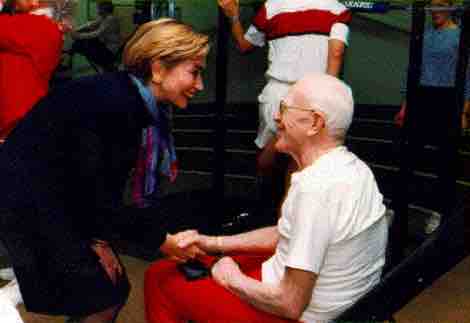Overview
The Clinton health care plan was a 1993 healthcare reform package proposed by the administration of President Bill Clinton and closely associated with the chair of the task force devising the plan, First Lady Hillary Rodham Clinton. Bill Clinton had campaigned heavily on health care in the 1992 U.S. presidential election. The task force itself was created in January 1993, but its own processes were somewhat controversial and drew litigation. Its goal was to come up with a comprehensive plan to provide universal health care for all Americans, which was to be a cornerstone of the administration's first-term agenda. A major health care speech was delivered by President Clinton to the U.S. Congress in September 1993. The core element of the proposed plan was an enforced mandate for employers to provide health insurance coverage to all of their employees through competitive but closely regulated health maintenance organizations (HMOs).
Many were unhappy with the way the system worked in the United States, where the cost of health insurance seemed increasingly unaffordable for the middle class. During this period, over 37 million Americans were completely without health insurance. However, opposition to the reform plan was heavy from conservatives, libertarians, and the health insurance industry. The industry produced a highly effective television ad, known as the "Harry and Louise" ad, in an effort to rally public support against the plan. Democrats, instead of uniting behind the President's original proposal, offered a number of competing plans of their own. By September 1994, the final compromise Democratic bill was declared dead by Senate Majority Leader George J. Mitchell.
Provisions
The bill was a complex proposal running more than 1,000 pages. The Clinton health plan required each U.S. citizen and permanent resident alien to become enrolled in a qualified health plan and forbade their dis-enrollment until covered by another plan. It listed the minimum coverage and maximum annual out-of-pocket expenses for each plan. It proposed the establishment of corporate "regional alliances" of health providers to be subject to a fee-for-service schedule. People below a certain set income level were to pay nothing. The act listed funding to be allocated to the states for the administration of this plan, beginning at $13.5 billion in 1993 and reaching $38.3 billion in 2003.
Task Force
Once in office, President Clinton quickly set up the Task Force on National Health Care Reform, headed by the First Lady. Hillary Clinton's leading role in this project was unprecedented for a presidential spouse. However, the plan ultimately backfired amid the barrage of fire from the pharmaceutical and health insurance industries and considerably diminished her own popularity. The plan became more controversial due to the First Lady's participation in the secret proceedings of the Health Care Task Force, which led to litigation from the Association of American Physicians and Surgeons, and due to the Act's preponderance of red tape.
Criticism
The outlook for the plan looked good in 1993; it had the support of a number of institutions like the American Medical Association and the Health Insurance Association of America. But in relatively short order, the political winds changed. As budget battles distracted the administration and the midterm elections of 1994 approached, Republicans began to recognize the strategic benefits of opposing reform.
Starting on September 28, 1993, Hillary Rodham Clinton appeared for several days of testimony before five congressional committees on health care. Opponents of the bill organized against it before it was presented to the Democratic-controlled Congress on November 20, 1993. Opposition to the Clinton plan was initiated by William Kristol and his policy group Project for the Republican Future, which is widely credited with orchestrating the plan's ultimate defeat through a series of now legendary "policy memos" faxed to Republican leaders. Conservatives, libertarians, the health insurance industry, and the conservative Heritage Foundation proceeded to campaign against the plan, criticizing it as being overly bureaucratic and restrictive of patient choice. Moderate conservatives dubbed the reform proposals “Hillarycare” and argued that the bill was an unwarranted expansion of the powers of the federal government that would interfere with people’s ability to choose the healthcare provider they wanted. Those further to the right argued that healthcare reform was part of a larger and nefarious plot to control the public.
Defeat
In August 1994, Democratic Senate Majority Leader George J. Mitchell introduced a compromise proposal that would have delayed requirements of employers until 2002 and exempted small businesses. However, even with Mitchell's bill, there were not enough Democratic Senators behind a single proposal to pass a bill, let alone stop a filibuster.
A few weeks later, Mitchell announced that his compromise plan was dead and that health care reform would have to wait at least until the next Congress. The defeat weakened Clinton politically, emboldened Republicans, and contributed to the notion that Hillary Clinton was a "big-government liberal" as decried by conservative opponents.

Clinton's attempt at health care reform
Bill Clinton made health care reform one of the highest priorities of his administration. He asked the First Lady to chair the Task Force on National Health Care Reform.